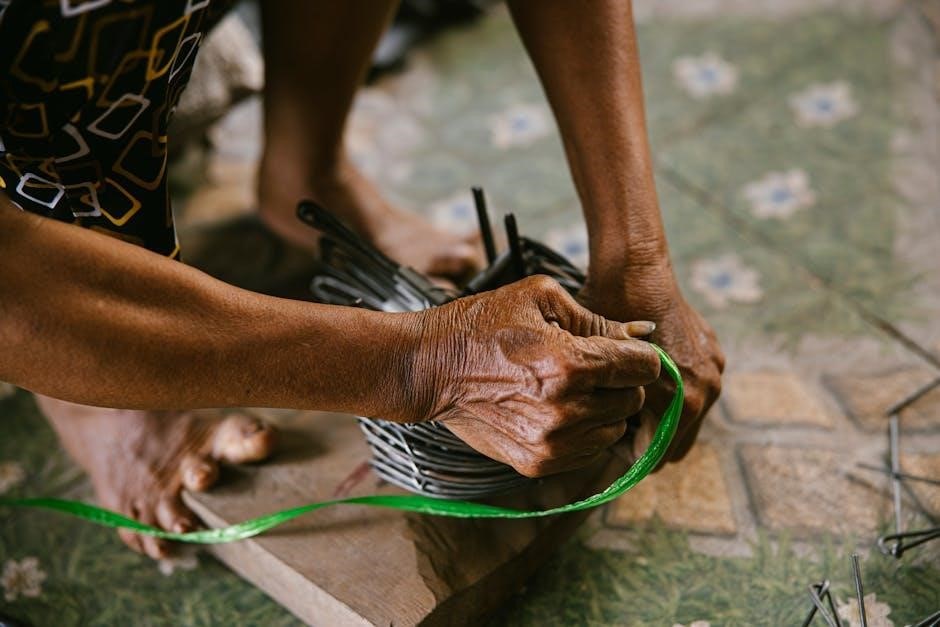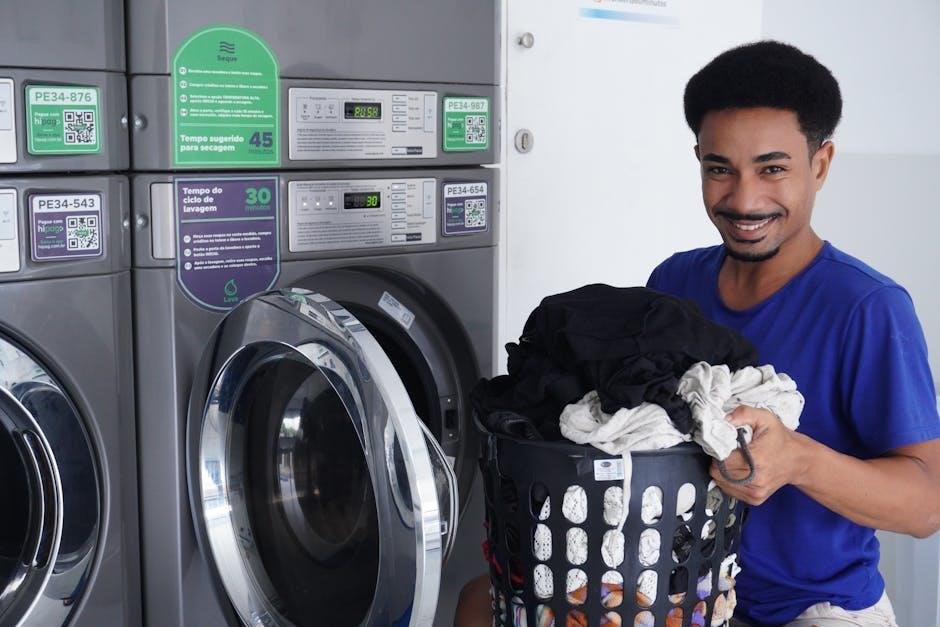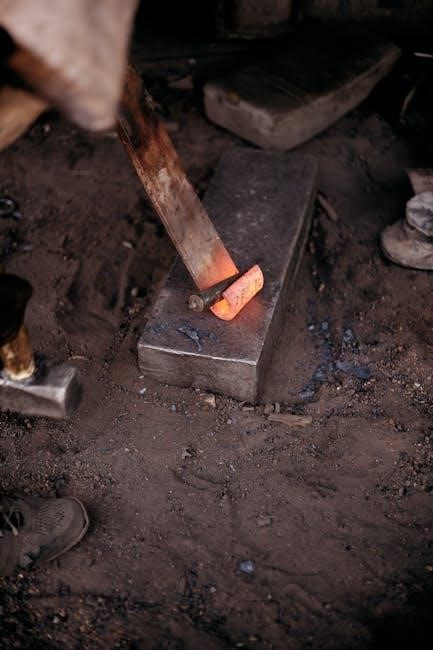Craftsman pressure washers are trusted for their durability and versatility, offering solutions for various cleaning tasks. With adjustable nozzles and eco-friendly settings, they ensure efficient and safe operation. Always follow the user manual for optimal performance and safety.
1.1 Overview of Craftsman Pressure Washers
Craftsman pressure washers are known for their durability and versatility, offering solutions for cleaning driveways, decks, and outdoor furniture. Available in various PSI and GPM ratings, they cater to light-duty and heavy-duty tasks. Electric and gas-powered models provide options for different user needs. These units often include multiple nozzles, soap tanks, and ergonomic designs for ease of use. They are designed to deliver efficient cleaning power while maintaining safety and environmental considerations, making them a popular choice for homeowners and professionals alike. Always follow the manufacturer’s guidelines for optimal performance.
1.2 Importance of Following Manufacturer Instructions
Following the manufacturer’s instructions is crucial for the safe and effective operation of Craftsman pressure washers. Proper setup, usage, and maintenance ensure optimal performance and longevity. Ignoring guidelines can lead to equipment damage or personal injury. Always refer to the user manual for specific details on assembly, detergent use, and troubleshooting. Adhering to these instructions helps maintain warranty coverage and ensures compliance with safety standards. This approach guarantees a satisfying cleaning experience while protecting both the user and the equipment from potential hazards.

Safety Precautions
Always follow safety guidelines to prevent injuries. Avoid using caustic liquids, as they can damage the washer or cause harm. Use only pressure washer-safe detergents. Refer to the user manual for detailed safety rules and ensure a safe environment during operation.
2.1 General Safety Rules
Always read the user manual thoroughly before operating your Craftsman pressure washer. Maintain a safe distance from flammable materials and keep children away. Ensure the area is clear of debris and obstacles. Never operate the pressure washer near open flames or sparks. Wear protective gear, including gloves and safety glasses, to prevent injury. Keep the pressure washer on a level surface and avoid overreaching. Store the unit properly after use, following all manufacturer guidelines. Ensure proper ventilation and follow all safety instructions to avoid accidents.
2.2 Warning Against Caustic Liquids
Never use caustic liquids with your Craftsman pressure washer, as they can cause severe damage to the machine and pose serious safety risks. Only use pressure washer-safe detergents or soaps, as specified in the user manual. Caustic liquids can corrode internal components, leading to costly repairs or rendering the unit inoperable. Always follow the manufacturer’s guidelines for approved cleaning agents to ensure safe and effective operation. Using unauthorized chemicals violates safety protocols and may void your warranty. Prioritize safety and longevity by adhering to these critical instructions.
2.3 Proper Use of Pressure Washer Safe Detergents
Using pressure washer-safe detergents is crucial for maintaining your Craftsman pressure washer’s performance and longevity. These detergents are specifically designed to work with the machine’s components and provide effective cleaning without causing damage. Always follow the manufacturer’s instructions for the correct dosage and application method. Exceeding recommended levels can leave residue or harm surfaces. Ensure the detergent is compatible with the type of cleaning you’re doing, whether it’s for cars, concrete, or siding. Proper use enhances cleaning efficiency and protects both the equipment and the surfaces being cleaned.

Assembly and Setup
Unbox and inspect all components for damage. Follow step-by-step assembly instructions in the manual. Ensure the pressure washer is on a level surface and properly aligned before use.
3.1 Unboxing and Initial Inspection
When unboxing your Craftsman pressure washer, carefully inspect all components for damage or defects. Verify the inclusion of all listed parts, such as the wand, nozzles, and detergent tank. Ensure the pressure washer and accessories are free from visible damage. Before assembly, review the manual to familiarize yourself with the components and their functions; This step ensures a smooth setup process and helps identify any missing or damaged items that may require replacement before use.
3.2 Step-by-Step Assembly Instructions
Begin by attaching the spray gun to the wand, ensuring a secure connection. Next, connect the high-pressure hose to both the pump and the gun. Install the desired nozzle by twisting it onto the wand tip until it clicks. Place the detergent tank in its designated holder and ensure it’s properly aligned. Finally, connect the water supply hose to the pump inlet. Tighten all connections firmly and double-check for leaks. Follow the manual for specific torque values and assembly details to ensure a safe and functional setup.
3.3 Attaching Accessories and Nozzles
To attach accessories and nozzles, start by ensuring the pressure washer is turned off and the pump is not under pressure. Twist the desired nozzle onto the wand tip until it clicks securely into place. For additional accessories, such as brush attachments or detergent injectors, align the connector with the wand’s receptacle and twist gently until locked. Always check connections for leaks before operation. Use only Craftsman-approved accessories to maintain compatibility and ensure safe, efficient performance. Properly securing nozzles and accessories is crucial for optimal cleaning results and equipment longevity.

Operating the Pressure Washer
Always start by checking oil and fuel levels, ensuring proper engine preparation. Begin with a low-pressure setting, gradually increasing as needed. Apply detergent safely, maintaining a steady motion to avoid damage. Keep the nozzle moving to prevent concentrated pressure on surfaces. Follow manual guidelines for optimal performance and safety.
4.1 Starting the Engine
Always place the pressure washer on a level surface before starting. Check oil and fuel levels, ensuring they meet the manufacturer’s specifications. Refer to the engine operator’s manual for specific instructions. Plug in the power cord or pull the recoil starter slowly until resistance is felt, then pull sharply. Allow the engine to warm up for a few seconds before applying pressure. Never start the engine near open flames or sparks, as fuel vapors are highly flammable. Follow all safety guidelines for safe operation.
4.2 Selecting the Right Nozzle for the Job
Selecting the correct nozzle is crucial for effective cleaning. The red nozzle (0°) is ideal for heavy-duty tasks like concrete. The green nozzle (25°) is best for general cleaning, while the yellow nozzle (40°) suits light-duty jobs. The black nozzle (65°) is designed for delicate surfaces. For tough stains, use a rotating nozzle. Always choose the right nozzle to avoid surface damage and ensure optimal cleaning results. Follow manufacturer guidelines for nozzle usage to maintain safety and efficiency during operation.
4.3 Basic Operating Techniques
Start with a steady stance, grip the spray gun firmly, and keep both hands on it to control recoil. Begin cleaning from a distance, adjusting as needed. Use wide, overlapping sweeps to cover the area evenly. Avoid pointing the nozzle at people, pets, or windows. Keep the nozzle at least 12 inches away from surfaces to prevent damage. Use the correct nozzle for the task and maintain consistent water flow. For tough areas, apply detergent first, let it sit, then rinse thoroughly. Always operate the pressure washer on a level, stable surface for safety.

Maintenance and Care
Regular maintenance ensures optimal performance. Check for wear, store properly, and replace worn parts. Follow manufacturer guidelines for seasonal storage and part replacements.
5.1 Regular Maintenance Checks
Regular maintenance is crucial for extending the life of your Craftsman pressure washer. Begin by inspecting all hoses and connections for signs of wear or leaks. Check the oil level in the engine, and top it off as needed using the recommended type. Ensure the air filter is clean and free of debris. Additionally, examine the spray gun and wand for any blockages or damage. It’s also important to flush the system after each use to prevent detergent buildup. Always refer to the user manual for specific guidance on these checks to ensure everything functions properly and safely. Regular maintenance not only prevents breakdowns but also ensures optimal performance during cleaning tasks. By staying on top of these simple checks, you can keep your pressure washer in excellent condition for years to come.
5.2 Storing the Pressure Washer
Proper storage of your Craftsman pressure washer is essential to maintain its performance and longevity. After use, ensure all fluids are drained to prevent freezing and corrosion. Clean the unit thoroughly, removing any dirt or debris. Store the pressure washer in a dry, well-ventilated area, away from direct sunlight and extreme temperatures. If storing for an extended period, apply a rust-inhibiting oil to metal components and consider using a manufacturer-recommended storage cover. Always keep the unit upright and secure to prevent tipping. For seasonal storage, refer to the manual for specific winterization steps.
5.3 Replacing Parts and Accessories
To maintain your Craftsman pressure washer’s performance, regular inspection and replacement of worn or damaged parts are crucial. Always use genuine Craftsman replacement parts to ensure compatibility and reliability. Refer to the owner’s manual for specific instructions on replacing components like nozzles, seals, or hoses. Clean and lubricate moving parts after installation to prevent friction and wear. If unsure about a replacement, consult the customer support hotline or visit an authorized service center for assistance. Proper replacement ensures safety and extends the lifespan of your pressure washer.

Troubleshooting Common Issues
Addressing common issues like low pressure or engine problems involves checking connections, ensuring proper detergent use, and following manual guidelines. Consult support if problems persist.
6.1 Identifying Common Problems
Common issues with Craftsman pressure washers include low water pressure, engine malfunction, and detergent system errors. Low pressure may result from clogged nozzles or incorrect nozzle size. Engine problems often stem from improper fuel use or neglected maintenance. Detergent issues arise from using non-recommended chemicals or incorrect application. Identifying these problems early ensures timely resolution. Always refer to the manual for diagnostic guidance and troubleshooting steps. If issues persist, contacting customer support or a professional is recommended to avoid further damage.
6.2 DIY Repair and Maintenance Tips
Regularly inspect hoses, nozzles, and connections for damage or blockages. Clean or replace clogged nozzles to maintain optimal pressure. Lubricate moving parts and check oil levels in gas models. Use only pressure washer-safe detergents to avoid damaging internal components. For electric models, ensure the power cord is undamaged. Store the unit in a dry, protected area during off-season. Refer to the user manual for specific DIY maintenance steps. Addressing issues promptly prevents costly repairs and extends the lifespan of your Craftsman pressure washer.
6.3 When to Contact a Professional
If you encounter major issues like engine failure, severe leaks, or electrical malfunctions, it’s best to contact a professional. Complex problems, such as internal pump damage or malfunctioning pressure regulators, require specialized tools and expertise. Always prioritize safety; if you’re unsure about diagnosing or repairing an issue, consult a certified technician. Additionally, for warranty-related repairs, professional assistance is often necessary to ensure compliance with manufacturer guidelines. Regular professional maintenance can also prevent future issues and extend the lifespan of your pressure washer.

Using Detergents and Chemicals
Use only pressure washer safe detergents/soaps to avoid damage. Never use caustic liquids. Follow manufacturer instructions for proper application and safety to ensure optimal cleaning results.
7.1 Recommended Detergents for Craftsman Pressure Washers
Craftsman pressure washers work best with specially designed, biodegradable detergents. These formulas are safe for surfaces and the environment while enhancing cleaning efficiency. Always avoid caustic liquids, as they can damage the washer or harm surfaces. Instead, opt for pressure washer-safe soaps that are compatible with the machine’s specifications. For tough jobs, heavy-duty detergents are recommended, while mildew-resistant options are ideal for outdoor surfaces. Follow the manufacturer’s guidelines for dilution ratios to ensure optimal performance and longevity of your pressure washer.
7.2 How to Apply Detergents Safely
When applying detergents to your Craftsman pressure washer, always use pressure washer-safe detergents to avoid damaging the machine or surfaces. Start by filling the detergent tank with the recommended amount, ensuring not to exceed the manufacturer’s guidelines. Avoid using caustic liquids, as they can harm components and surfaces. Wear protective gloves and eyewear to prevent skin and eye irritation. Apply the detergent evenly, starting from a low pressure setting to prevent excessive spray. Keep the nozzle at a safe distance from surfaces to avoid damage. After application, allow the detergent to sit for the recommended time before rinsing thoroughly with clean water. This ensures effective cleaning and prevents residue buildup.
7.3 Avoiding Harmful Chemicals
Avoid using caustic liquids, bleach, or ammonia with your Craftsman pressure washer, as they can damage components and harm surfaces. Only use detergents specifically designed for pressure washers, as they are safe for both the machine and the environment. Never mix chemicals, as this can create toxic fumes or reactions. Always read detergent labels and follow the manufacturer’s guidelines. If unsure, test a small area first to ensure compatibility. This prevents damage to surfaces and ensures safe, effective cleaning.

Winterization and Seasonal Storage
Winterize your Craftsman pressure washer by draining all fluids and protecting components from freezing. Store in a dry, protected area to maintain performance and longevity during off-season.
8.1 Preparing for Winter Storage
To prepare your Craftsman pressure washer for winter, drain all fluids, including fuel and water. Disconnect the water supply and hoses, and consider using antifreeze in the system if recommended. Clean the unit thoroughly to remove dirt and debris. Store the pressure washer in a dry, protected area away from freezing temperatures. Ensure all accessories are securely stored to prevent damage. Proper preparation ensures the washer remains in good condition and ready for use when needed again.
8.2 Draining Fluids and Protecting Components
Drain all fluids, including fuel, water, and detergent, to prevent freezing and corrosion. Disconnect hoses and store them separately. Use a pump to remove residual water from the system. Apply antifreeze to protect internal components if recommended. Lubricate seals and moving parts to maintain functionality. Cover or store the unit in a dry, frost-free area to safeguard against damage. Properly protecting components ensures longevity and prevents costly repairs when restarting in the spring.
8.3 Maintaining the Pressure Washer During Off-Season
Regular off-season maintenance ensures your pressure washer remains in top condition. Inspect for damage or wear on hoses, seals, and connections. Clean the exterior thoroughly to remove dirt and debris. Store the unit in a dry, protected area away from direct sunlight. Apply rust-inhibiting oil to metal parts and ensure all components are dry to prevent corrosion. Check and replenish lubricants as needed. Proper off-season care extends the lifespan of your pressure washer and ensures it performs optimally when needed again.
Environmental Considerations
Adopt eco-friendly practices by using biodegradable detergents and minimizing water usage. Properly dispose of chemicals to prevent environmental harm and ensure sustainable cleaning with your pressure washer.
9.1 Eco-Friendly Cleaning Practices
Eco-friendly cleaning practices are essential for minimizing environmental impact. Use biodegradable detergents specifically designed for pressure washers to avoid harming plants and water sources. Opt for low-pressure settings when possible to reduce water consumption. Always follow manufacturer guidelines for detergent usage to prevent excessive chemical runoff. Regularly inspect and maintain your pressure washer to ensure efficient water use and prevent leaks. By adopting these practices, you can effectively clean while protecting the environment and promoting sustainable cleaning habits.
9.2 Proper Disposal of Chemicals and Waste
Proper disposal of chemicals and waste is crucial for environmental protection. Always check local regulations for disposing of cleaning solutions and detergents. Never pour chemicals down drains or storm drains, as they can harm waterways. Instead, take leftover substances to hazardous waste collection facilities. Ensure all containers are properly sealed and labeled. Follow manufacturer guidelines for disposing of pressure washer-related waste. Safe disposal practices help protect ecosystems and comply with environmental laws, ensuring a cleaner and healthier planet for future generations.
9.3 Reducing Water Usage
To reduce water usage, use low-pressure settings for light tasks and select nozzles with lower flow rates. Avoid unnecessary washing and ensure the pressure washer is turned off when not in use. Fix any leaks promptly, as they can waste significant water over time. Consider using eco-friendly modes or adjusting the spray width to minimize water flow while maintaining cleaning efficiency; Always follow manufacturer guidelines to optimize water usage without compromising cleaning results.

Accessories and Enhancements
Accessories like brush attachments and detergent tanks enhance versatility. Upgrades such as extended hoses or spray guns improve efficiency. Explore optional equipment to tailor your pressure washer for specific tasks.
10.1 Optional Attachments for Versatility
Craftsman pressure washers offer a variety of optional attachments to enhance functionality. These include brush attachments for scrubbing surfaces, wide-sweep nozzles for large areas, and extension wands for hard-to-reach spaces. Additional accessories like detergent tanks and rotating brushes provide specialized cleaning solutions. These attachments allow users to customize their pressure washer for specific tasks, ensuring efficiency and effectiveness in different cleaning scenarios. By leveraging these options, users can maximize their equipment’s potential and achieve professional-grade results for various projects.
10.2 Upgrading Your Pressure Washer
Upgrading your Craftsman pressure washer can enhance its performance and adaptability. Consider adding a higher-pressure hose, a more efficient spray gun, or upgrading to a rotary nozzle for tougher cleaning tasks. Additional features like a larger detergent tank or a heated water option can also improve functionality. When upgrading, ensure all parts are compatible with your Craftsman model and follow manufacturer guidelines for installation. Regularly check for new accessories and upgrades to keep your pressure washer performing at its best and tackle a wider range of cleaning projects effectively.
10.3 Recommended Additional Equipment
To enhance your cleaning experience, consider adding essential accessories like a high-pressure hose for extended reach or a rotary nozzle for tougher surfaces. A brush attachment is ideal for gentle cleaning of delicate areas, while a tarps and covers kit protects your equipment during storage. Additional spray tips provide versatility for different cleaning tasks. Safety gear, such as gloves and goggles, is also recommended. Finally, invest in a pressure washer storage bag and a detergent kit for convenience and optimal performance. Always ensure compatibility with your Craftsman model.
By following the instructions and maintaining your Craftsman pressure washer, you ensure optimal performance and safety. Regular upkeep and proper detergent use extend its lifespan and effectiveness.
11.1 Summary of Key Instructions
Always follow the manufacturer’s guidelines for setup, operation, and maintenance. Use only pressure washer-safe detergents and avoid caustic liquids. Regularly inspect and maintain components like hoses and nozzles. Store the unit properly, especially during winter, by draining fluids and protecting vulnerable parts. For optimal performance, adhere to safety precautions, such as wearing protective gear and ensuring a stable operating surface. Refer to the user manual for troubleshooting and DIY repairs. Proper care ensures longevity and reliable service from your Craftsman pressure washer.
11.2 Final Tips for Optimal Performance
Always follow the user manual for optimal performance and longevity. Regularly inspect hoses and connections for wear. Use only recommended detergents to avoid damage. Reduce water usage by selecting the right nozzle and pressure setting. Wear protective gear, including gloves and goggles, during operation. For complex issues, consult a professional. Eco-friendly practices ensure environmental safety while maintaining efficiency. Proper care ensures your Craftsman pressure washer delivers consistent results over time.

References and Further Reading
Consult the official Craftsman manuals and guides for detailed instructions. Visit manualzilla for PDF downloads. Check online reviews and tutorials for additional tips and troubleshooting.
12.1 Official Craftsman Manuals and Guides
Official Craftsman manuals provide comprehensive guides for setup, operation, and maintenance. These resources include detailed safety precautions, troubleshooting tips, and warranty information. Available online, they ensure users can access essential instructions anytime. Always refer to these manuals for accurate information tailored to your specific model. Download from trusted sources like Manualzilla or the official Craftsman website for reliable guidance.
12.2 Online Resources and Tutorials
Online resources and tutorials offer extensive support for Craftsman pressure washer users. Websites like Manualzilla provide downloadable PDF manuals, while video platforms like YouTube feature setup and operation guides. Forums and DIY communities share tips for troubleshooting and maintenance. Official Craftsman websites also host user manuals, ensuring access to reliable information. These resources help users optimize their pressure washer’s performance and address common issues effectively. Utilize these platforms to enhance your understanding and maintain your equipment properly.
12.3 Customer Support and Help Lines
Craftsman offers dedicated customer support to assist with pressure washer inquiries. Their helpline provides troubleshooting, maintenance tips, and repair guidance. Users can contact support via phone, email, or live chat for personalized help. The customer service team is available during extended hours to address concerns promptly. Additionally, official Craftsman websites provide direct access to support resources, ensuring users receive reliable assistance. This comprehensive support system helps users resolve issues efficiently and maintain their pressure washers for optimal performance.

Be First to Comment